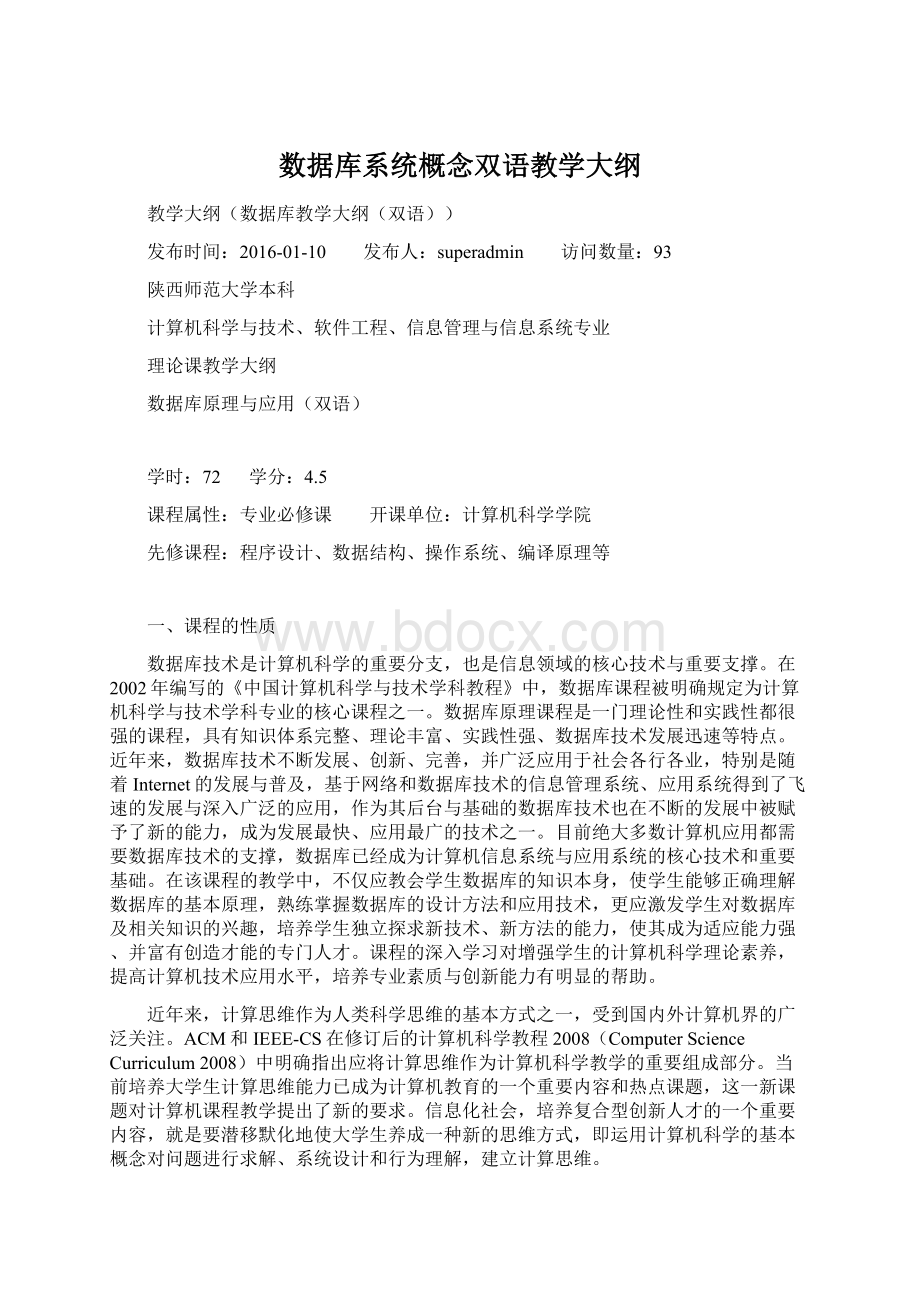数据库系统概念双语教学大纲.docx
《数据库系统概念双语教学大纲.docx》由会员分享,可在线阅读,更多相关《数据库系统概念双语教学大纲.docx(28页珍藏版)》请在冰豆网上搜索。

数据库系统概念双语教学大纲
教学大纲(数据库教学大纲(双语))
发布时间:
2016-01-10 发布人:
superadmin 访问数量:
93
陕西师范大学本科
计算机科学与技术、软件工程、信息管理与信息系统专业
理论课教学大纲
数据库原理与应用(双语)
学时:
72 学分:
4.5
课程属性:
专业必修课 开课单位:
计算机科学学院
先修课程:
程序设计、数据结构、操作系统、编译原理等
一、课程的性质
数据库技术是计算机科学的重要分支,也是信息领域的核心技术与重要支撑。
在2002年编写的《中国计算机科学与技术学科教程》中,数据库课程被明确规定为计算机科学与技术学科专业的核心课程之一。
数据库原理课程是一门理论性和实践性都很强的课程,具有知识体系完整、理论丰富、实践性强、数据库技术发展迅速等特点。
近年来,数据库技术不断发展、创新、完善,并广泛应用于社会各行各业,特别是随着Internet的发展与普及,基于网络和数据库技术的信息管理系统、应用系统得到了飞速的发展与深入广泛的应用,作为其后台与基础的数据库技术也在不断的发展中被赋予了新的能力,成为发展最快、应用最广的技术之一。
目前绝大多数计算机应用都需要数据库技术的支撑,数据库已经成为计算机信息系统与应用系统的核心技术和重要基础。
在该课程的教学中,不仅应教会学生数据库的知识本身,使学生能够正确理解数据库的基本原理,熟练掌握数据库的设计方法和应用技术,更应激发学生对数据库及相关知识的兴趣,培养学生独立探求新技术、新方法的能力,使其成为适应能力强、并富有创造才能的专门人才。
课程的深入学习对增强学生的计算机科学理论素养,提高计算机技术应用水平,培养专业素质与创新能力有明显的帮助。
近年来,计算思维作为人类科学思维的基本方式之一,受到国内外计算机界的广泛关注。
ACM和IEEE-CS在修订后的计算机科学教程2008(ComputerScienceCurriculum2008)中明确指出应将计算思维作为计算机科学教学的重要组成部分。
当前培养大学生计算思维能力已成为计算机教育的一个重要内容和热点课题,这一新课题对计算机课程教学提出了新的要求。
信息化社会,培养复合型创新人才的一个重要内容,就是要潜移默化地使大学生养成一种新的思维方式,即运用计算机科学的基本概念对问题进行求解、系统设计和行为理解,建立计算思维。
数据库课程的知识体系完整,既有经典理论成果奠定的坚实基础,又有在实践中发挥巨大作用的先进技术,其中很多知识点都为计算思维提供了很好的诠释和生动的案例。
二、教学目的
课程学习的基本目标是正确理解数据库的基本原理,熟练掌握数据库的设计方法和应用技术。
高级目标是通过课程学习,掌握基于数据库、数据仓库的数据分析技术,并能够将工程思维与数学思维结合起来,培养对实际应用问题的抽象和自动化能力,培养计算思维能力。
三、教学内容
数据库系统是对数据进行存储、管理、处理和维护的软件系统,是现代计算环境中的一个核心部分。
随着计算机硬件、软件技术的飞速发展和计算机系统在各个行业的广泛应用,数据库技术的发展尤其迅速,引人注目。
本课程包括数据库系统、数据库设计、数据库语言和数据库系统实现等方面的基本概念,数据库系统实现的核心技术,数据库查询语言、查询优化、模式设计、数据仓库、数据库应用开发、基于对象的数据库和XML、数据存储和查询、事务管理、数据挖掘与信息检索以及数据库系统体系结构等方面的内容。
四、学时分配
章
课程内容
学时
1
Chapter1:
Introduction
4
2
Chapter2:
IntroductiontotheRelationalModel
4
3
Chapter3:
IntroductiontoSQL
8
4
Chapter4IntermediateSQL
4
5
Chapter5AdvancedSQL
4
6
Chapter6:
FormalRelationalQueryLanguages
6
7
Chapter7DatabaseDesignandtheE-RModel
4
8
Chapter8:
RelationalDatabaseDesign
6
9
Chapter9:
ApplicationDevelopmentandAdministration
2
12
Chapter12:
QueryProcessing
6
13
Chapter13:
QueryOptimization
4
14
Chapter14:
Transactions
4
15
Chapter15:
ConcurrencyControl
6
16
Chapter16:
RecoverySystem
4
17
Chapter17:
DatabaseSystemArchitectures
2
18
Chapter18:
ParallelDatabases(选修)
2
19
Chapter19:
DistributedDatabases
2
20
Chapter20:
DataWarehousingandMining(选修)
2
合计
72
五、教学方式
本课程以课内学习和信息化教学平台课外学习结合的方式,采用以多媒体教学手段为主,充分发挥多媒体教学手段信息量大的特点。
本课程概念和上机操作较多,必须通过做大量的练习和上机实验来加深对概念的理解和掌握,从而达到消化、掌握所学知识的目的,提高动手能力。
独立完成作业是学好本课程的重要手段。
鼓励学生多做题,多看参考书籍。
鼓励同学们利用丰富便捷的课程资源大力开展“自主性学习”,把课堂学习和课余钻研结合起来,以期很好地完成课程的学习任务。
六、考核方式
期末考试(70%)+平时作业(5%)+信息化平台课外学习(5%)+数据库系统项目设计(20%)。
七、教材及教学参考书
教材:
[1]AbrahamSilberschatz,HenryF.Korth,S.Sudarshan.DATABASESYSTEMCONCEPTS(SixthEdition),高等教育出版社,2014.7,影印版
参考教材:
[2]杨冬青(改编,译者),西尔伯沙茨(AbrahamSilberschatz)(作者),HenryF.Korth(作者),S.Sudarshan(作者),李红燕(译者),唐世渭(译者),等(译者).数据库系统概念(原书第6版·本科教学版),2013.1
[3]JeffreyUllman,JenniferWidom.数据库系统基础教程(英文版)(第3版),机械工业出版社,第3版,2008.8
[4]郑阿奇,刘启芬,顾韵华,SQLServer数据库教程(2008版),人民邮电出版社2012.3
[5]闪四清,SQLSERVER2008基础教程(高等学校计算机应用规划教材),清华大学2010.8
八、教学基本内容及要求
Chapter1:
Introduction
1.教学基本要求
Adatabase-managementsystem(DBMS)isacollectionofinterrelateddataandasetofprogramstoaccessthosedata.Thecollectionofdata,usuallyreferredtoasthedatabase,containsinformationrelevanttoanenterprise.TheprimarygoalofaDBMSistoprovideawaytostoreandretrievedatabaseinformationthatisbothconvenientandefficient.
Databasesystemsaredesignedtomanagelargebodiesofinformation.Managementofdatainvolvesbothdefiningstructuresforstorageofinformationandprovidingmechanismsforthemanipulationofinformation.Inaddition,thedatabasesystemmustensurethesafetyoftheinformationstored,despitesystemcrashesorattemptsatunauthorizedaccess.Ifdataaretobesharedamongseveralusers,thesystemmustavoidpossibleanomalousresults.
Becauseinformationissoimportantinmostorganizations,computerscientistshavedevelopedalargebodyofconceptsandtechniquesformanagingdata.Theseconceptsandtechniquesformthefocusofthisbook.Thischapterbrieflyintroducestheprinciplesofdatabasesystems.
本章重点:
1)Databasemanagementsystem
2)PurposeofDatabaseSystems
3)ViewofData
4)DataDefinitionLanguage
5)DataManipulationLanguage
6)DataModels
7)Queryprocessor
8)TransactionManagement
9)Databasearchitecture
10)DataMining
11)DatabaseAdministrator
2.教学具体内容
说明本课程的性质,与学习其他课程的关系,介绍本课程的主要教学内容,主要参考书。
1.1Database-SystemApplications
1.2PurposeofDatabaseSystems
1.3ViewofData
1.4DatabaseLanguages
1.5RelationalDatabases
1.6DatabaseDesign
1.7DataStorageandQuerying
1.8TransactionManagement
1.9DatabaseArchitecture
1.10DataMiningandInformationRetrieval
1.11SpecialtyDatabases
1.12DatabaseUsersandAdministrators
1.13HistoryofDatabaseSystems
1.14Summary
3.考核要求:
1)理解:
数据库常用的基本术语,包括数据库、数据库管理系统、实例、模式、物理模式、逻辑模式、子模式、物理数据独立性、数据库语言、数据库用户和DBA。
2)理解:
数据库系统的优点。
3)理解:
数据视图和数据抽象的三层结构。
4)理解:
数据模型,包括实体-联系模型和关系模型。
5)理解:
事务管理。
6)理解:
数据库系统的基本组成结构及存储管理器和查询处理器的作用。
7)了解:
数据库系统的发展历程。
Chapter2:
IntroductiontotheRelationalModel
1.教学基本要求
Adatamodelisacollectionofconceptualtoolsfordescribingdata,datarelationships,datasemantics,andconsistencyconstraints.Inthispart,wefocusontherelationalmodel.
Therelationalmodel,whichiscoveredinChapter2,usesacollectionoftablestorepresentbothdataandtherelationshipsamongthosedata.Itsconceptualsimplicityhasledtoitswidespreadadoption;todayavastmajorityofdatabaseproductsarebasedontherelationalmodel.Therelationalmodeldescribesdataatthelogicalandviewlevels,abstractingawaylow-leveldetailsofdatastorage.Theentity-relationshipmodel,discussedlaterinChapter7(inPart2),isahigher-leveldatamodelwhichiswidelyusedfordatabasedesign.
Therelationalmodelistodaytheprimarydatamodelforcommercialdataprocessingapplications.Itattaineditsprimarypositionbecauseofitssimplicity,whicheasesthejoboftheprogrammer,comparedtoearlierdatamodelssuchasthenetworkmodelorthehierarchicalmodel.
Inthischapter,wefirststudythefundamentalsoftherelationalmodel.Asubstantialtheoryexistsforrelationaldatabases.WestudythepartofthistheorydealingwithqueriesinChapter6.InChapters7through8,weshallexamineaspectsofdatabasetheorythathelpinthedesignofrelationaldatabaseschema,whileinChapters12and13wediscussaspectsofthetheorydealingwithefficientprocessingofqueries.
本章重点:
1)StructureofRelationalDatabases
2)Keys,ForeignKey,Referentialintegrityconstraints
3)SchemaDiagram
4)RelationalQueryLanguages
5)RelationalOperations
6)RelationalAlgebra
本章难点:
SchemaDiagram
2.教学具体内容
2.1StructureofRelationalDatabases
2.2DatabaseSchema
2.3Keys
2.4SchemaDiagrams
2.5RelationalQueryLanguages
2.6RelationalOperations
2.7Summary
3.考核要求:
1)理解:
关系模型的基本概念(包括属性、域、关系、元组、元组变量;数据库模式、数据库实例、关系模式、关系实例;超码、候选码、主码、外码等)和关系数据库结构。
2)熟练掌握:
根据主码、外码画出数据库模式图。
3)理解:
关系查询语言,理解关系操作。
4)掌握:
用关系代数表达查询要求。
Chapter3:
IntroductiontoSQL
1.教学基本要求
Thereareanumberofdatabasequerylanguagesinuse,eithercommerciallyorexperimentally.Inthischapter,aswellasinChapters4and5,westudythemostwidelyusedquerylanguage,SQL.
AlthoughwerefertotheSQLlanguageasa“querylanguage,”itcandomuchmorethanjustqueryadatabase.Itcandefinethestructureofthedata,modifydatainthedatabase,andspecifysecurityconstraints.
Itisnotourintentiontoprovideacompleteusers’guideforSQL.Rather,wepresentSQL’sfundamentalconstructsandconcepts.IndividualimplementationsofSQLmaydifferindetails,ormaysupportonlyasubsetofthefulllanguage.。
本章重点:
1)SQLDataDefinition
2)SQLQueryStructure
3)Naturaljoinoperation
4)Correlationname(Correlationvariable,tuplevariable)
5)Setoperations
6)NullValues
7)Aggregationfunctions
8)NestedSub-queries
9)ScalarSub-queries
10)DatabaseModification
本章难点:
1)NullValues
2)Aggregationfunctiongroupby
3)NestedSub-queries
2.教学具体内容
3.1OverviewoftheSQLQueryLanguage
3.2SQLDataDefinition
3.3BasicStructureofSQLQueries
3.4AdditionalBasicOperations
3.5SetOperations
3.6NullValues
3.7AggregateFunctions
3.8NestedSub-queries
3.9ModificationoftheDatabase
3.10Summary
3.考核要求:
1.熟练掌握:
定义基本表。
2.熟练掌握:
用SQL语句表达单表查询、连接查询。
3.熟练掌握:
用SQL语句表达涉及查询结果排序、分组处理的查询。
4.熟练掌握:
用SQL语句表达数据的更新。
5.基本掌握:
用SQL语句表达嵌套查询。
6.理解:
空值的概念。
Chapter4IntermediateSQL
1.教学基本要求
Inthischapter,wecontinueourstudyofSQL.WeconsidermorecomplexformsofSQLqueries,viewdefinition,transactions,integrityconstraints,moredetailsregardingSQLdatadefinition,andauthorization.
本章重点:
1)Jointypes
2)Viewdefinition
3)Viewupdate
4)IntegrityConstraints
5)Authorization
本章难点:
Viewupdate
2.教学具体内容
4.1JoinExpressions
4.2Views
4.3Transactions
4.4IntegrityConstraints
4.5SQLDataTypesandSachems
4.6Authorization
4.7Summary
3.考核要求:
1)熟练掌握:
外联查询。
2)熟练掌握:
视图定义和查询。
3)熟练掌握:
完整性限制定义。
4)熟练掌握:
授权和回收。
5)基本掌握:
视图更新。
Chapter5AdvancedSQL
1.教学基本要求
InChapters3and4,weprovideddetailedcoverageofthebasicstructureofSQL.Inthischapter,wecoversomeofthemoreadvancedfeaturesofSQL.1WeaddresstheissueofhowtoaccessSQLfromageneral-purposeprogramminglanguage,whichisveryimportantforbuildingapplicationsthatuseadatabasetostoreandretrievedata.Wedescribehowproceduralcodecanbeexecutedwithinthedatabase,eitherbyextendingtheSQLlanguagetosupportproceduralactions,orbyallowingfunctionsdefinedinprocedurallanguagestobeexecutedwithinthedatabase.Wedescribetriggers,whichcanbeusedtospecifyactionsthataretob